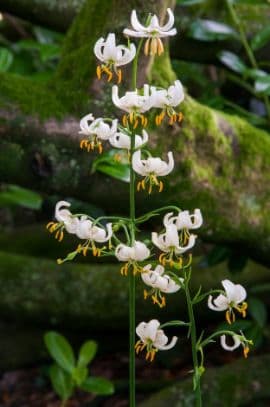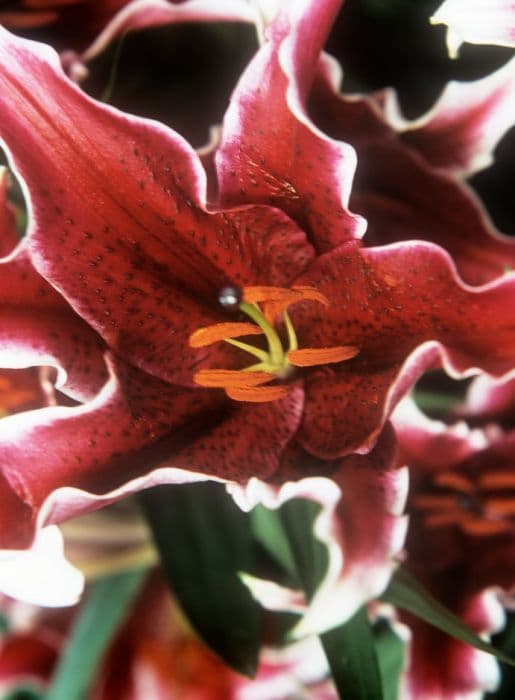Homerus lily Lilium 'Homerus' (PBR) (Viia/b-c)

ABOUT
The Lilium 'Homerus', generally known as a lily, is a captivating plant characterized by its striking trumpet-shaped flowers, which showcase a dazzling display of colors. These blossoms are often a blend of bright hues, frequently revealing a gradient of color from the center to the tips of the petals. As for the petals themselves, they are smooth and curved, resembling an elegant swirl that adds to the flower's visual allure. The lily's vibrant flowers are attached to sturdy stems, which hold them aloft and give the impression of a colorful and buoyant arrangement. The foliage of the plant is also noteworthy; the leaves are glossy and have a rich, deep green color, which forms an attractive backdrop to the brilliance of the flowers. Each leaf is elongated, with a pointed tip and smooth edges, arranged in a spiral pattern around the stem, which adds to the overall elegance and geometry of the plant's structure. While small in size, the visual impact of the Lilium 'Homerus' is significant, exuding a sense of exotic beauty and delicate charm that can be appreciated by nature lovers and garden enthusiasts alike.
About this plant
 Names
NamesSynonyms
Homerus Lily
Common names
Lilium 'Homerus' (PBR) (Viia/b-c)
 Toxicity
ToxicityTo humans
The plant commonly known as lily can be toxic to humans if ingested. While they are primarily a concern for pets, certain types of lilies can also cause mild to moderate symptoms in humans. The most common symptoms of lily poisoning in humans might include gastrointestinal discomfort, such as nausea, vomiting, or diarrhea. In more severe cases, it could lead to dehydration from prolonged vomiting and diarrhea. It's important to keep lilies out of reach of children who might accidentally ingest parts of the plant. If someone does consume part of a lily, it's advisable to seek medical attention to manage any potential symptoms.
To pets
Lilies are extremely toxic to cats, and can be hazardous to dogs as well, although cats are more sensitive. Ingesting even a small amount of any part of the lily plant can lead to severe kidney damage in cats. Symptoms of lily poisoning in pets may include vomiting, lethargy, lack of appetite, and increased or decreased urination. In the absence of prompt and appropriate veterinary treatment, the cat could suffer from kidney failure, which could potentially lead to death. Pet owners who suspect their animal has ingested any part of a lily should seek immediate veterinary assistance.
 Characteristics
CharacteristicsLife cycle
Perennials
Foliage type
Deciduous
Color of leaves
Green
Flower color
Mixed
Height
3 feet (91 cm)
Spread
1 foot (30 cm)
Plant type
Bulb
Hardiness zones
4
Native area
Asia
Benefits
 General Benefits
General Benefits- Ornamental Appeal: Lilium 'Homerus' adds aesthetic value to gardens with its striking flowers.
- Low Maintenance: This plant typically requires minimal care once established, making it suitable for gardeners of all skill levels.
- Pollinator Attraction: The flowers can attract bees, butterflies, and other pollinating insects, benefiting the biodiversity of the garden.
- Seasonal Interest: Blooming typically in summer, it provides seasonal color and interest in the landscape.
- Cut Flower Use: The blooms are long-lasting and are excellent for use in floral arrangements.
- Variety in Landscaping: Being a bulbous plant, it offers a different texture and form compared to other perennials.
- Versatility: Suitable for borders, beds, and containers, allowing for use in various garden designs.
- Adaptability: It can thrive in a range of different soils as long as they provide adequate drainage.
 Medical Properties
Medical PropertiesThis plant is not used for medical purposes.
 Air-purifying Qualities
Air-purifying QualitiesThis plant is not specifically known for air purifying qualities.
 Other Uses
Other Uses- Lily 'Homerus' petals can be used to create natural dyes for fabrics, yielding a range of colors depending on the mordant used in the dye process.
- The sturdy stems of the lily 'Homerus' can be incorporated into floral art or used as natural supports in gardening for smaller plants.
- The pollen of the lilies has been known to be used by some artists to create yellow pigment for use in their artworks.
- Dried petals of the lily 'Homerus' can be added to potpourri mixes for an aromatic and visual enhancement to home décor.
- Lily 'Homerus' can be used as a natural insect repellant; its strong fragrance is disliked by certain insects, offering a chemical-free bug deterrent.
- Pressed or dried lily 'Homerus' flowers are often used in scrapbooking and papermaking to add botanical elements to the crafts.
- Flower essences made from lily 'Homerus' are sometimes used in aromatherapy and holistic practices to promote emotional well-being.
- Used in culinary presentations, the non-toxic parts of lily 'Homerus' can add an exotic and elegant touch to gourmet dishes.
- The large, showy flowers of lily 'Homerus' make excellent natural confetti for weddings or celebrations in environmentally sensitive areas.
- Gardeners with ponds or water features can use the lily 'Homerus' to help provide shade for aquatic life and control the growth of algae through shading.
Interesting Facts
 Feng Shui
Feng ShuiThe Lily is not used in Feng Shui practice.
 Zodiac Sign Compitability
Zodiac Sign CompitabilityThe Lily is not used in astrology practice.
 Plant Symbolism
Plant Symbolism- Purity: The lily is widely regarded as a symbol of purity and innocence, often used in religious contexts to represent these virtues.
- Beauty: Both historically and in contemporary times, lilies are considered to be a representation of beauty and elegance due to their striking appearance and form.
- Renewal: As many lilies are known to bloom in spring, they are associated with new beginnings and the rejuvenation of the soul.
- Motherhood: In some cultures, lilies are symbolic of motherhood and fertility, embodying the nurturing aspects of life.
- Transcendence: The lily can also represent spiritual transcendence, with the flower reaching upwards suggesting a yearning for the divine or a higher state of consciousness.
 Water
WaterOriental lilies, including the Lilium 'Homerus', should be watered thoroughly once a week with about 1 to 1.5 gallons of water per plant. They prefer consistently moist, well-drained soil, especially during the growing period. It's crucial to avoid overwatering, which can lead to bulb rot. Water at the base of the plant to minimize wetting the foliage, which can lead to fungal diseases. During hot, dry periods, you may need to water twice a week to maintain adequate moisture levels.
 Light
LightOriental lilies like Lilium 'Homerus' grow best in a spot that receives full sun to partial shade. They need at least 6 hours of direct sunlight a day to thrive. Choose a location where they will be protected from strong afternoon sun, which can be too intense, especially in hotter climates.
 Temperature
TemperatureOriental lilies, such as Lilium 'Homerus', thrive in temperatures between 60 to 75 degrees Fahrenheit. They can survive in temperatures as low as 40 degrees Fahrenheit in the ground and can tolerate summer highs up to 85 degrees Fahrenheit. To promote healthy growth and blooming, avoid placing them in areas where temperatures exceed these ranges for extended periods.
 Pruning
PruningPruning Oriental lilies like Lilium 'Homerus' generally involves removing the spent flower heads after blooming to promote healthy growth and possibly more blooms. However, leave the stems and leaves in place until they turn yellow and die back naturally in the fall. This allows the plant to store energy in the bulb for the next growing season. Deadheading, or the removal of old flowers, can be done as needed throughout the blooming period.
 Cleaning
CleaningAs needed
 Soil
SoilThe best soil mix for the Lily 'Homerus' is well-draining and rich in organic matter, like a blend of loam, peat moss, and perlite. The soil pH should be slightly acidic to neutral, ranging between 6.0 and 7.0.
 Repotting
RepottingLilies including the Lily 'Homerus' should be repotted every 2-3 years or when the bulb has outgrown its container. It's best done in the fall after the plant has finished blooming.
 Humidity & Misting
Humidity & MistingLily 'Homerus' prefers moderate humidity levels, but it's adaptable and does not require specific humidity conditions. Average indoor humidity should be sufficient.
 Suitable locations
Suitable locationsIndoor
Place in bright, indirect light and ensure good air circulation.
Outdoor
Plant in sunny spot with well-draining soil; protect from strong winds.
Hardiness zone
4-9 USDA
 Life cycle
Life cycleLilium 'Homerus', commonly known as a variety of Lily, begins its life cycle as a bulb which goes through a period of dormancy, usually during the colder winter months. In spring as temperatures rise, the bulb sends up shoots and develops into a stem with leaves, utilizing stored energy within the bulb. The plant continues to grow and eventually produces buds, which bloom into distinctive flowers, often during early to mid-summer, depending upon the climate. After flowering, the plant may produce seeds within capsules if pollination has occurred. As the growing season ends, the above-ground parts of the Lily begin to die back, and the plant re-enters a period of dormancy, with the bulb surviving underground. Throughout its life, the bulb can also produce offsets, leading to the creation of new plants, thereby continuing the lifecycle.
 Propogation
PropogationPropogation time
Spring-Early Summer
Propogation: The most popular method of propagating the Lily 'Homerus' (Lilium 'Homerus') is through bulb division. This plant multiplies via bulblets, which form at the axils of the scales of the main bulb. The ideal time for bulb division is in the fall, after the foliage has died back but before the ground freezes. To propagate through bulb division, carefully dig up the lily bulbs and gently separate the bulblets from the parent bulb. Replant these bulblets immediately at a depth of about 4 to 6 inches (10 to 15 centimeters) in well-draining soil, spaced approximately 8 to 12 inches (20 to 30 centimeters) apart to allow for growth. Water them thoroughly after planting to help establish roots. This method allows for a relatively fast increase of plants and is generally simple to perform, even for novice gardeners.





![Lily [Roselily Chelsea]](/_next/image?url=https%3A%2F%2Fplants-admin.emdemapps.com%2Fimages%2Fplants%2F%2Fimages%2F604b584f6f830.png&w=640&q=75)



